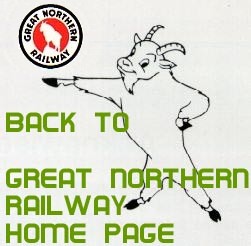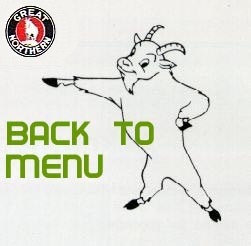|


| |
10/10/2000 from:
Chuck Hatler
Saginaw, TX, USA
abchat@earthlink.com
Interests: history, paper and memorabilia, the future of GN (BNSF) and industry. Presently working as a crew planner at BNSF's NOC in Ft.
Worth.
OK, here is some info on operations in Great Falls. This is a long detailed post, and I hope that it is pertinent information to most (OK, some) of our list members.
The building on the right of the depot, Railroad Square Express, was the Division Office Building. Pre-BN, this was the Butte Division. On the ground floor, closest to the depot (south end), was the Railway Express facility. Upstairs over this was the superintendent, chief clerk, master mechanic, etc. At the other end of the upstairs was the traffic department. Trainmaster offices were about in the middle. Downstairs, opposite the REA, originally, was the commissary department (back when the trains in and out of Great Falls had dining cars). There was even a walk-in cooler or freezer in the back. Also the Special Agents had their offices in the breezeway. Acme Fast Freight, a freight
consolidator/forwarder had their office in this north end, on the east (street side). On the platform side, there was a rail spur that ran right up along side the building, as far as the breezeway--it served a couple of warehouses just north of the office building, and (I'm supposing) way back when, allowed inbound commissary loads to be spotted for unloading into the storage area--there was a double door at platform level there. I was familiar with the inside of this part of the building, because the employees credit union occupied part of it when I was young, and my dad was the manager.
The police station is in what was the old General Motors Parts Distribution Center. They had rail access on the east side of their building for sure. Don't remember how many doors, though. There is a long low building just east of the police station with a 2 story office on the north end. This was the freight house. It had 4 tracks that extended about half way up the west side. The rest of the west side was where the long haul trucks loaded and unloaded. Great Falls was a major break-bulk and LCL point. As I understand it, cars would be spotted to all four tracks, with the doors lined up. As the car closest to the building was unloaded, they would drop a ramp from it to the car on the second track, unload it, drop another ramp to the third car, and finally to the car on the fourth track. On the east side of the freight house was where the SPUD (Short Pick Up and Delivery) trucks loaded and unloaded. See the fine article in this quarter's GNRHS mailing for some great photos of this operation that Richard Yaremko managed to find.
Yes, the building across the river with "Great Northern Railway" spelled out in white brick is still the diesel house. Not sure when it was built--do know it was post-WWII. The roundhouse stood surrounding the turntable. At one point, the round house was nearly an entire circle... I'm looking at a copy of an old aerial photo and I count between 35 and 38 stalls. There is nothing left of the roundhouse except the concrete pad and the turntable.
So far as I know, there is no specific name for the Great Falls yard. An employee once told me that it had been built to be a hump yard, and there does seem to be an incline from the east end, by the yard office, to the west end, out past Central Ave West, but I cannot confirm this tidbit. Most switching is done from the east end, because the cars do roll west.
Not sure which other building you are referring to, but there also was a two-track metal paint shop for painting cars that came out of the car shop, a stores supply building, a multi-track car shop, a backshops that was actually two buildings connected by a transfer table. Part of the backshop is now Ryan Mercantile's warehouse, the car shop (which was white wood) has had concrete blocks added to it and is home to the local Mayflower Moving agency. Not sure who is using the rest of the buildings. At one point in time, they even built or rebuilt a series of steam engines in the backshops--can't tell you which series, but I'll bet Fr Dale, or someone else on the list can. There was even a first aid building, with a nurse on duty on days. This was a small building right next to the transfer table. There was a pair of tracks on the north side of the diesel house that was the coach yard. Coaches were cleaned and serviced here. They use those tracks now for holding engines. There was also a steam plant with a tall smokestack just east of the diesel house. This plant provided steam for all the facilities, including those across the river! The boiler operator also had the chore or pleasure of blowing the whistle that was the official start and stop time for the shops, including their 20 minute lunch break. We lived about 5 or 6 blocks from the steam plant and we used his whistle to know what time it was, without looking at a clock. In later years, there was a large oil storage tank just across the mainline from the diesel house. There was also a hobo jungle on the banks of the Missouri River just north of the bridge. There is now an office building in its place.
Great Falls, whether by design or accident, was an extremely important place on the GN. A lot of it had to do with the fact that the Anaconda Company had their smelter in Great Falls, and so there was a lot of traffic to be handled. One of the other theories of why it was such an important place was that CO Jenks, longtime VP of Operations had personal interests in Great Falls and he made sure the place had lots of employees. Again, I can't say how true that is, but I had lunch with his son, Downing Jenks, of the MOPAC, and he told me that CO owned one of the coal mines at Stockett, and also managed the Park Hotel (which was across the street from the depot). As I recall the story, CO had worked for the railroad and for some reason had been fired. So he went to Great Falls, and was working there, when Jim Hill summoned him to St. Paul. Jim wanted CO back, but CO said he couldn't come back account he had this coal mine to take care of. So Mr. Hill wrote a note to the purchasing agent telling him to buy all the coal from CO's mine, inground at 10 cents a ton! This was the low grade coal that so many engineers and firemen did not like because it did not steam well. Another possibility that there was so much activity at Great Falls was that it was the home base for the Montana Central. My dad estimates that when he came to Great Falls in 1949 there were 700 railroad employees in the area. The railroad was always second in employment to the ACM, until the Air Force came in force during WWII.
Hope this answers most of the questions you had about Great Falls. Fr. Dale wrote a great article on the Montana Central a few years ago and there are more tidbits in there that may be helpful. It should still be available as a reprint from the GNRHS.
 
|